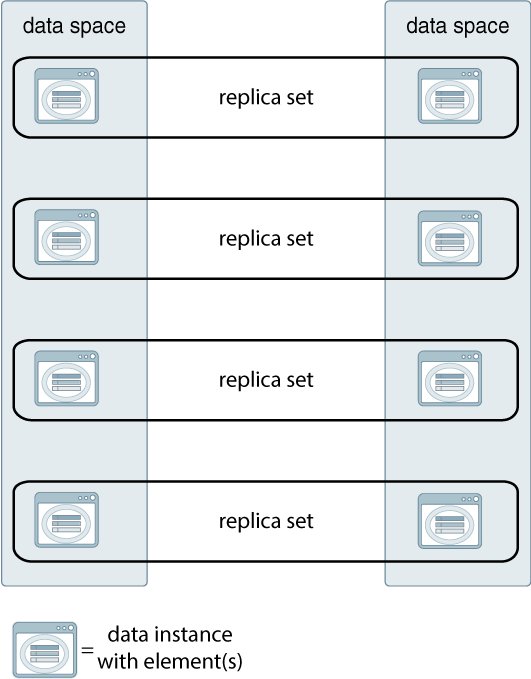TimesTen Scaleout Specific Features
In addition to the TimesTen general features, the following features are supported within TimesTen Scaleout
High Availability Features for TimesTen Scaleout
The architecture for TimesTen Scaleout provides high performance and supports high availability.
TimesTen Scaleout enables you to create a grid of interconnected instances running on one or more hosts. You can create a database hosted in the grid and the data stored in that database is distributed across the instances of the grid. Each instance contains one piece (an element) of every database hosted in the grid.
Figure 1-2 highlights this portion of the architecture.
-
TimesTen Scaleout provides high availability by enabling you to specify that the system maintain more than one copy of every item of data within a database, known as K-safety. The number of copies of data is referred to as the k-factor. Your choice to maintain more than one copy protects you from data loss in the event of a single failure. So a grid with k=1 does not provide high availability (as there is only one copy of the data); however, a grid with k > 1 provides high availability.
Each copy of the database is logically contained within a data space, which logically groups the instances that contain one entire copy of a database. There are always as many data spaces as the grid k-factor.
-
TimesTen Scaleout spreads the work for the database across data instances in parallel, which computes the results of your SQL statements faster. the data in your database is distributed into elements.
-
Your application can connect to any data instance in the grid and transparently access all of the data in the database without having to know where specific data is located.
-
A replica set is a set of database elements with identical contents (the multiple copies resulting from the specified k-factor). Each replica set always contains k elements. The separate elements within a replica set are located across separate data spaces. If one element fails, your connection can be rerouted to the other element in the replica set, if it is still available.
-
You can add or remove instances from your grid to:
-
Expand or shrink the storage capacity of your database as necessary.
-
Expand or shrink the computing resources of your database to meet the performance requirements of your applications.
-
Figure 1-2 shows a database within the grid where the k-factor is set to 2.
Figure 1-2 Performance and High Availability Architecture Within TimesTen Scaleout

Description of "Figure 1-2 Performance and High Availability Architecture Within TimesTen Scaleout"
See Architectural Overview of TimesTen Scaleout in this guide and TimesTen Scaleout Architecture in the Oracle TimesTen In-Memory Database Scaleout User's Guide.
Transparent Data Distribution
While TimesTen Scaleout distributes your data across multiple instances, applications do not need to know how data is distributed. When an application connects to any instance in the grid, it has access to all of the data of the database without having to know the location of specific data.
Knowledge about the distribution of data is never required in TimesTen Scaleout, but it can be used to tune the performance of your application. You can use this knowledge to exploit locality where possible.
See Data Transparency in the Oracle TimesTen In-Memory Database Scaleout User's Guide.
Online Elastic Scalability
TimesTen Scaleout enables you to add or remove instances in order to control both performance and the storage capacity of your database.
Adding instances improves the throughput of your workload by providing the additional computing resources of the hosts running those instances. If your business needs change, then removing instances (and their hosts) enables you to meet your targets with fewer resources.
See Scalability in the Oracle TimesTen In-Memory Database Scaleout User's Guide.
Automatic High Availability Through K-Safety
TimesTen Scaleout provides high availability and fault tolerance when you have
multiple copies of data located across separate hosts with K-safety (k).
When one copy of the data is unavailable due to a software error, SQL statements are automatically redirected to the other copy of the data (if possible). In the meantime, TimesTen Scaleout synchronizes the data on the failed system with the rest of the database.
See TimesTen Scaleout Specific Features and High Availability and Fault Tolerance in the Oracle TimesTen In-Memory Database Scaleout User's Guide.
Single Point for Administration and Monitoring
You do not need to log onto every host within a grid in order to perform management
activities. Instead, you conduct all management activity from a single management
instance using the ttGridAdmin utility.
ttGridAdmin utility to define, deploy, and check on the
status of each database.
You can also use the ttGridRollout utility or the Oracle SQL Developer GUI (both of which use the ttGridAdmin utility under the covers to run all requests) to facilitate creating, deploying, and managing your grid.
See Centralized Management in the Oracle TimesTen In-Memory Database Scaleout User's Guide.